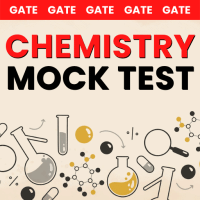Chemistry Exam > Chemistry Questions > Identify the function of hemocyanin and the m...
Start Learning for Free
Identify the function of hemocyanin and the metal responsible for it:
- a)O2 transport and Fe
- b)O2 transport and Cu
- c)Electron transport and Fe
- d)Electron transport and Cu
Correct answer is option 'B'. Can you explain this answer?
Most Upvoted Answer
Identify the function of hemocyanin and the metal responsible for it:a...
Function and Metal Responsible for Hemocyanin
Function:
Hemocyanin is a copper-containing protein that is responsible for transporting oxygen in the blood of various invertebrates, such as crustaceans, mollusks, and arachnids. It is an alternative to hemoglobin, which is the oxygen-transporting protein found in vertebrates.
Metal Responsible:
The metal responsible for the function of hemocyanin is copper. Copper is a transition metal that has the ability to bind to oxygen molecules. In hemocyanin, copper ions bind to oxygen molecules, allowing for the transport of oxygen in the blood.
Hemocyanin and Oxygen Transport:
Hemocyanin is able to transport oxygen due to its unique structure. It consists of multiple subunits, each containing a copper ion that can bind to an oxygen molecule. When oxygen is present, the copper ions in hemocyanin become oxidized, causing a color change from blue to colorless. This allows for the release of oxygen to the tissues that need it.
Hemocyanin has a higher affinity for oxygen than hemoglobin, which allows for efficient oxygen transport even in low oxygen environments. This is particularly important for invertebrates that live in aquatic environments with low oxygen levels.
Conclusion:
In summary, hemocyanin is a copper-containing protein that is responsible for transporting oxygen in the blood of invertebrates. Copper is the metal responsible for the function of hemocyanin, as it is able to bind to oxygen molecules. Hemocyanin's unique structure allows for efficient oxygen transport, even in low oxygen environments.
Function:
Hemocyanin is a copper-containing protein that is responsible for transporting oxygen in the blood of various invertebrates, such as crustaceans, mollusks, and arachnids. It is an alternative to hemoglobin, which is the oxygen-transporting protein found in vertebrates.
Metal Responsible:
The metal responsible for the function of hemocyanin is copper. Copper is a transition metal that has the ability to bind to oxygen molecules. In hemocyanin, copper ions bind to oxygen molecules, allowing for the transport of oxygen in the blood.
Hemocyanin and Oxygen Transport:
Hemocyanin is able to transport oxygen due to its unique structure. It consists of multiple subunits, each containing a copper ion that can bind to an oxygen molecule. When oxygen is present, the copper ions in hemocyanin become oxidized, causing a color change from blue to colorless. This allows for the release of oxygen to the tissues that need it.
Hemocyanin has a higher affinity for oxygen than hemoglobin, which allows for efficient oxygen transport even in low oxygen environments. This is particularly important for invertebrates that live in aquatic environments with low oxygen levels.
Conclusion:
In summary, hemocyanin is a copper-containing protein that is responsible for transporting oxygen in the blood of invertebrates. Copper is the metal responsible for the function of hemocyanin, as it is able to bind to oxygen molecules. Hemocyanin's unique structure allows for efficient oxygen transport, even in low oxygen environments.
Free Test
FREE
| Start Free Test |
Community Answer
Identify the function of hemocyanin and the metal responsible for it:a...
Active site is Cu..in hemocyanin.

|
Explore Courses for Chemistry exam
|

|
Question Description
Identify the function of hemocyanin and the metal responsible for it:a)O2 transport and Feb)O2 transport and Cuc)Electron transport and Fed)Electron transport and CuCorrect answer is option 'B'. Can you explain this answer? for Chemistry 2025 is part of Chemistry preparation. The Question and answers have been prepared according to the Chemistry exam syllabus. Information about Identify the function of hemocyanin and the metal responsible for it:a)O2 transport and Feb)O2 transport and Cuc)Electron transport and Fed)Electron transport and CuCorrect answer is option 'B'. Can you explain this answer? covers all topics & solutions for Chemistry 2025 Exam. Find important definitions, questions, meanings, examples, exercises and tests below for Identify the function of hemocyanin and the metal responsible for it:a)O2 transport and Feb)O2 transport and Cuc)Electron transport and Fed)Electron transport and CuCorrect answer is option 'B'. Can you explain this answer?.
Identify the function of hemocyanin and the metal responsible for it:a)O2 transport and Feb)O2 transport and Cuc)Electron transport and Fed)Electron transport and CuCorrect answer is option 'B'. Can you explain this answer? for Chemistry 2025 is part of Chemistry preparation. The Question and answers have been prepared according to the Chemistry exam syllabus. Information about Identify the function of hemocyanin and the metal responsible for it:a)O2 transport and Feb)O2 transport and Cuc)Electron transport and Fed)Electron transport and CuCorrect answer is option 'B'. Can you explain this answer? covers all topics & solutions for Chemistry 2025 Exam. Find important definitions, questions, meanings, examples, exercises and tests below for Identify the function of hemocyanin and the metal responsible for it:a)O2 transport and Feb)O2 transport and Cuc)Electron transport and Fed)Electron transport and CuCorrect answer is option 'B'. Can you explain this answer?.
Solutions for Identify the function of hemocyanin and the metal responsible for it:a)O2 transport and Feb)O2 transport and Cuc)Electron transport and Fed)Electron transport and CuCorrect answer is option 'B'. Can you explain this answer? in English & in Hindi are available as part of our courses for Chemistry.
Download more important topics, notes, lectures and mock test series for Chemistry Exam by signing up for free.
Here you can find the meaning of Identify the function of hemocyanin and the metal responsible for it:a)O2 transport and Feb)O2 transport and Cuc)Electron transport and Fed)Electron transport and CuCorrect answer is option 'B'. Can you explain this answer? defined & explained in the simplest way possible. Besides giving the explanation of
Identify the function of hemocyanin and the metal responsible for it:a)O2 transport and Feb)O2 transport and Cuc)Electron transport and Fed)Electron transport and CuCorrect answer is option 'B'. Can you explain this answer?, a detailed solution for Identify the function of hemocyanin and the metal responsible for it:a)O2 transport and Feb)O2 transport and Cuc)Electron transport and Fed)Electron transport and CuCorrect answer is option 'B'. Can you explain this answer? has been provided alongside types of Identify the function of hemocyanin and the metal responsible for it:a)O2 transport and Feb)O2 transport and Cuc)Electron transport and Fed)Electron transport and CuCorrect answer is option 'B'. Can you explain this answer? theory, EduRev gives you an
ample number of questions to practice Identify the function of hemocyanin and the metal responsible for it:a)O2 transport and Feb)O2 transport and Cuc)Electron transport and Fed)Electron transport and CuCorrect answer is option 'B'. Can you explain this answer? tests, examples and also practice Chemistry tests.

|
Explore Courses for Chemistry exam
|

|
Signup for Free!
Signup to see your scores go up within 7 days! Learn & Practice with 1000+ FREE Notes, Videos & Tests.


















